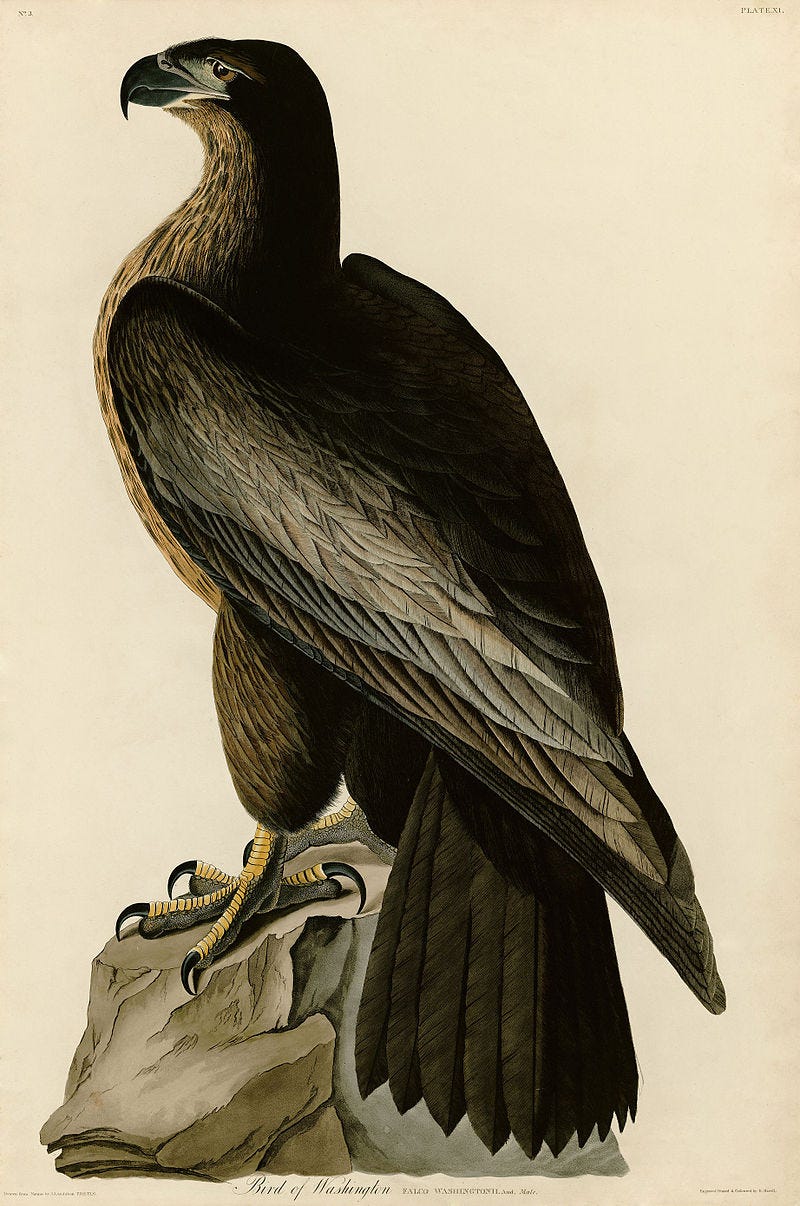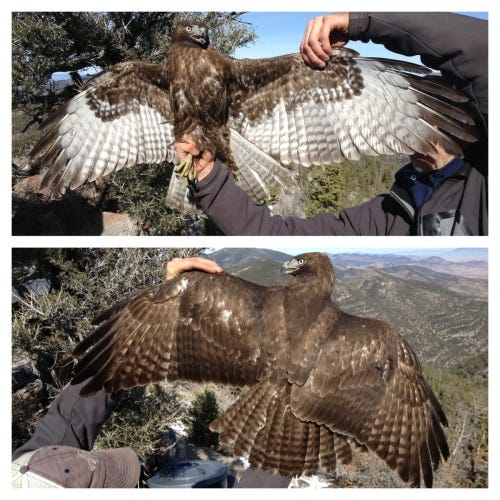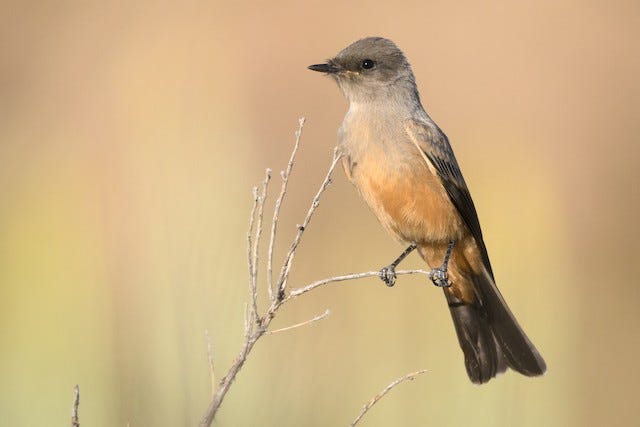Have you ever thought about how an animal got its name? Why do we call a camel a “camel,” after all? Or a mallard a mallard? For some birds, it’s pretty obvious. The male red-winged blackbird is an excellent example of how he got his name. But then you look at the female, and you’ll notice there’s barely anything red-winged (or black) about her at all.
The red-tailed hawk is another one. A lot of the time they have a rusty red tail, easily distinguishing them from all our other hawks. But they don’t get their namesake red tail until they enter their second-year molt. There are also many morphs of the red-tailed hawk, the darkest of which don’t really have a visibly red tail at all.
Bird names, as it turns out, are often confusing. The Carolina wren is found in many more states than just the Carolinas. The house sparrow? That one’s pretty apt actually. They do live near houses. Great horned-owl? Another good one. But the bald eagle? Not bald! Not even thinning!!!
I am just getting back from a trip to the west coast, returning from fabulous, sunny, Southern California. Officially I went out there to attend an engagement ceremony and visit friends, but the entire b-plot of the trip was dedicated to birding. I’ve done some birding in LA before (I spent a summer in Burbank for school) but the engagement ceremony was out near Pomona, so there were some new opportunities for new birds.
The west coast is spoiled with birds in a way we Easterners can only dream of. Over 400 species of birds can be found in the Western US and Canada, compared to our measly 200 or so usual suspects. I was able to add a few species to my list this time, but mostly saw familiar faces. Among the birds I did see though, it struck me how many eponyms I was encountering.
Eponyms are nouns which are named for a person. For instance, Lake Victoria, which is named for Queen Victoria. Eponyms are common in the natural world, especially so in ornithology. On this trip alone I spotted Townsend’s solitaire, Bewick’s wren, Anna’s hummingbird, Cassin’s kingbird, and Say’s phoebe, to name a few.
In the field, my main aggravation is that these names are utterly meaningless when it comes to identifying or distinguishing the birds. “Black phoebe” tells you what a bird looks like. “Western kingbird” tells you where the bird lives. “Say’s phoebe?” Try telling your friends you just saw a Say’s phoebe and watch them say, “Phoebe says what?”
I’d never really paid much attention to eponyms before I became aware of the Bird Names for Birds movement, which kicked off in 2020, in response, in part, to the George Floyd protests. Bird Names for Birds is an effort to remove eponyms from english bird names and the responses have been predictably polarizing. Through my social media bubble I mainly see fervent support for the group, though there are some vocal detractors as well.
As the chief givers of English bird names, the American Ornithological Society also weighs in occasionally. In addition to doling out bird names, the AOS does other things too, such as reject proposals to change bird names, and form ad-hoc committees to further discuss changing bird names.
The practice of naming birds after (white) people is a racist remnant from colonial scientific practices, and the good people over at Bird Names for Birds have put together a helpful encyclopedia of these assholes, so you can read about their crimes in fuller detail. Most of these men were colonial naturalists and collectors, though a few of the people on the list are the wives and daughters for whom birds were occasionally named as well.
In total, there are about 150 birds in North America that have eponymous names, all of which you can comb through here. We of course have eponymous birds in the East. The Cooper’s hawk for instance is named for some guy named Cooper and not the barrel makers of the world. But as I was studying up for my trip and then encountering all these western birds for the first time, it really struck me just how many of were named for intrepid/pioneering/Indian-killing westward explorers (and their wives and daughters).
As I returned to the east coast I considered my biases. Why have I not paid so much attention to the eponymous eastern birds? Is it because they’re not new to me? Or perhaps my own personal history is so entrenched in New English colonialism that I’ve been blind to the imperialism in my own backyard.
Meanwhile, the morning after my return, the National Audubon Society put out a long-awaited (and well-timed) statement from CEO Elizabeth Gray, concluding that no, the Audubon Society will not be changing its name. The statement was met with much outrage from Audubon Staff, voiced by the Bird Union (who have dropped the Audubon name themselves).
Again, in response to the George Floyd Protests, the National Audubon Society’s name has for a few years now been under scrutiny. John James Audubon was a gifted painter, and at one time the country’s preeminent wildlife artist, but he also was a slaveholder, a vocal critic of emancipation, hated the indigenous, and even stole human remains in pursuit of his pseudo-scientific endeavors. He also was accused of plagiarism both while he was alive and posthumously. He wasn’t even that good of a naturalist! Just take a look at his famous plate, “the Bird of Washington,” a bird which John James Audubon either invented or seriously misidentified.

John James Audubon was by all accounts a bad guy. But none of his, uh, “shortcomings,” were taken into consideration when Minna B. Hall and Harriet Hemenway founded the first chapter of the Audubon Society in 1896. Audubon died in 1851, but his reputation (and celebrity) as a naturalist, painter, and bird-lover endured.
If the National Audubon Society’s decision not to change their name leaves a bad taste in your mouth, consider turning your attention to Nature Forward, formerly named the Audubon Naturalist Society (and not affiliated with the National Audubon Society or any of its chapters). We also have the Seattle chapter of the Audubon Society, which remains dedicated to its effort to change its name–and is on track to announce their new name in June. And then there’s the long-tailed duck, whose name change was accepted in the year 2000 by the AOS as its old name was in fact a derogatory term used against indigenous people.
So name changes are possible, and they are meaningful. That’s why we all started saying rock pigeon and stopped saying rock dove–cause we decided pigeons are foul city-dwelling sky rats, and not the holy beacon of purity their genetically-identical white counterparts represent.
We have drawn this unspoken agreement that rock doves are in fact pigeons, and that red-winged blackbirds don’t have to have to be black or have red wings. We agree that the identity of the bird is immutable no matter what we call it. In a sense, this is too bad, because otherwise you’d never have to worry about misidentifying a bird ever again.
But the identity of a bird (or in the case of the Audubon Society, an organization) becomes lost as soon as it is associated with a person—whether it was named in honor of someone or eponymously. The creature (or organization) assumes the identity, or at least the history, of whom it is named for. That darling pink-throated hummingbird isn’t just a hummingbird, it’s Anna’s hummingbird. You know, Anna’s hummingbird? Named for for Anne d’Essling, french courtier? What? You’ve never heard of Anne d’Essling, french courtier? Well! She has a whole hummingbird named after her! A whole-ass species of bird with its own unique DNA and natural history–and it occupies one sentence of her Wikipedia article.

Even if René Lesson, the first westerner to describe Anna’s hummingbird, had named the hummingbird after himself like the rest of these masturbatory naturalists do, it still begs the question: who the hell is this guy?
My point, I guess, is that the horrors of scientific colonialism still linger. Eponymous names are based in the idea that America, whether New England, California, or wherever else, needs to be charted by colonial settlers and her bounteous creation cataloged in the western sciences. The idea is that without such recognition, these species are undiscovered or don’t exist. It is this idea that allowed John James Audubon to shoot an immature bald eagle and claim he’d discovered a new species. These names don’t tell us anything useful; they’re baggage from a bygone era of naturalists whose work and belief systems have been refuted.
So is it any different for the National Audubon Society? Perhaps so, because of name recognition. Perhaps so, because the member base doesn’t share the same outrage as my social media bubble. Perhaps so, because the implications of the name are a historical footnote, rather than a symbol of violence. The name change, or lack there of, can be quieted with an ad hoc committee, an open letter, or other nonprofit battle technique to stall the outrage until the Audubon name fades back into association with birds and nothing more.
Ultimately a name, every name—my name, your name—is a crass attempt to give us the language to all discuss the same person, place, or thing. And some names are especially clumsy or ill-fitting. The color of the tail doesn’t change the identity of the red-tailed hawk, but it can signal to the birder who they are looking at. The same is true for the National Audubon Society. If you’ve never heard of John James Audubon, the name would mean nothing at all. If you know he’s the bird guy—then he’s the bird guy! But for too many others the Audubon name means a lot more than that. We’ve drawn back the curtain on his history and we don’t like what we see.
For further reading:
The Myth of John James Audubon
https://www.audubon.org/news/the-myth-john-james-audubonEponymous bird names feed ornithologists’ vanity, without enlightening the science
https://matthewhalley.wordpress.com/2022/03/29/eponymous-bird-names-feed-ornithologists-vanity-without-enlightening-the-science/Eponyms have no place in 21st-century biological nomenclature (note: this one is paywalled)
https://www.nature.com/articles/s41559-023-02022-y






Wonderful and very informative article! Keep them coming Andrew….!